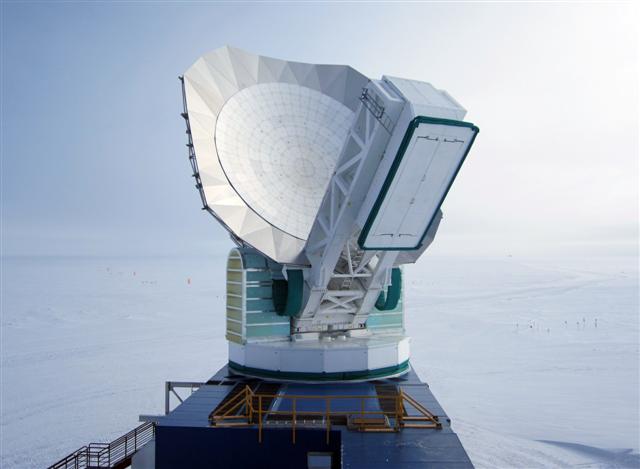|
Explosive eventSouth Pole Telescope eyes birth of first massive galaxiesPosted September 14, 2012
New data from the South Pole Telescope (SPT) Extremely bright, active galaxies formed and fully illuminated the universe by the time it was 750 million years old, or about 13 billion years ago, according to a new report published in the Sept. 1 print edition of The Astrophysical Journal. The latest results are based on a new analysis that combines measurements taken by the National Science Foundation The data provide new constraints on the universe’s first era of galaxy formation, called the Epoch of Reionization. Most astronomers think that early stars came to life in massive gas clouds, generating the first galaxies. The energetic light pumped out by these stars is thought to have ionized the hydrogen gas in and around the galaxies, creating “ionization bubbles” millions of light years across that left a lasting, telltale signature in the CMB. “We find that the Epoch of Reionization lasted less than 500 million years and began when the universe was at least 250 million years old,” said lead author Oliver Zahn The first epoch of ionization occurred after the universe was born in the Big Bang “Studying the Epoch of Reionization is important because it represents one of the few ways by which we can study the first stars and galaxies,” said study co-author John Carlstrom The epoch’s short duration suggests that reionization was more explosive than scientists had previously thought. It suggests that massive galaxies played a key role in reionization, because smaller galaxies would have formed much earlier. Rapid reionization also argues against many proposed astrophysical phenomena that would slow the process. This is only the beginning of what astronomers expect to learn about reionization from the SPT. The current results are based on only the first third of the telescope’s full survey. “We expect to measure the duration of reionization to within 50 million years with the current survey,” said study co-author Christian Reichardt The finding follows a report in the journal Nature last month that the SPT discovered a massive galaxy cluster where stars are forming at the highest rate ever observed. [See previous article — Cluster of discoveries: South Pole Telescope finds fastest star-making region in the universe.] The 280-ton telescope stands more than 60 meters tall and is the largest astronomical telescope ever built in Antarctica’s clear, dry air. It sits at an elevation of more than 2,800 meters on the polar plateau. Because of its location at the Earth’s axis, it can conduct long-term observations of a single patch of sky. The University of Chicago leads the SPT collaboration, which includes research groups from Argonne National Laboratory NSF-funded research in this article: John Carlstrom, John Ruhl, Joseph Mohr, William Holzapfel and Nils Halverson, University of Chicago, Award No. 0638937 |



For USAP Participants |
For The Public |
For Researchers and EducatorsContact UsNational Science FoundationOffice of Polar Programs Geosciences Directorate 2415 Eisenhower Avenue, Suite W7100 Alexandria, VA 22314 Sign up for the NSF Office of Polar Programs newsletter and events. Feedback Form |



